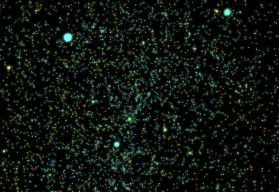Wheel of Stars

Click the image to watch and hear my musical clock made of the stars.
 To make this, I downloaded public data from Hipparcos, a satellite launched by the European Space Agency in 1989 that accurately measured over a hundred thousand stars. The data I downloaded contains position, parallax, magnitude, and color information, among other things.
To make this, I downloaded public data from Hipparcos, a satellite launched by the European Space Agency in 1989 that accurately measured over a hundred thousand stars. The data I downloaded contains position, parallax, magnitude, and color information, among other things.
I used this information to plot the brightest stars, and cause them to revolve about Polaris (the North Star) very slowly, as the stars appear to do. Like the night sky, this is a sidereal time clock — it takes nearly 24 hours for the stars to fully rotate. You’ll notice some familiar constellations, such as the Big Dipper in there. As the stars cross zero and 180 degrees, indicated by the center line, the clock plays an individual note, or chime for each star. The pitch of the chime is based on the star’s BV measurement (which roughly corresponds to color or temperature). The volume is based on the star’s magnitude, or apparent brightness, and the stereo panning is based on the position on the screen (use headphones to hear it better).
Basically, this is a very literal kind of “music of the spheres,” and is typical of my projects, which often involve circles and music. This idea for making a music box out of stars was a natural progression from some previous projects of mine, like the Whitney Music Box, and Musical Chess, which you might also enjoy.
If you’d like a large, high fidelity Wheel of Stars to project on the ceiling of your home, gallery or museum, contact me. I’d love to build you one, or provide you with plans and software.


October 6th, 2009 at 3:34 am
I was so impressed I spread it around the Science Division of the European Space Agency, and I think our Hipparcos Communication Scientist is going to put it up on the official Hipparcos Science Team site.
More news if/when it happens.
October 6th, 2009 at 7:23 am
Oh very cool! You should know that I’m planning a few variations over the next few days, including one which actually makes use of the parallax data, rather than magnitude – which seems fitting, considering the purpose of the mission…
October 7th, 2009 at 3:47 pm
My friend was looking at Boingboing last night and I saw your star clock.
http://www.boingboing.net/2009/10/06/a-musical-clock-made.html
October 7th, 2009 at 4:03 pm
What a coincidence! I made this star clock and it got on BoingBoing! :)
October 8th, 2009 at 10:01 am
Keep us informed of progress .. and read the response mails to the mail you sent to ‘contact the webmaster’ (i.e. me) on our site (www.rssd.esa.int) .. we need your permission to reproduce any images etc. on our site.